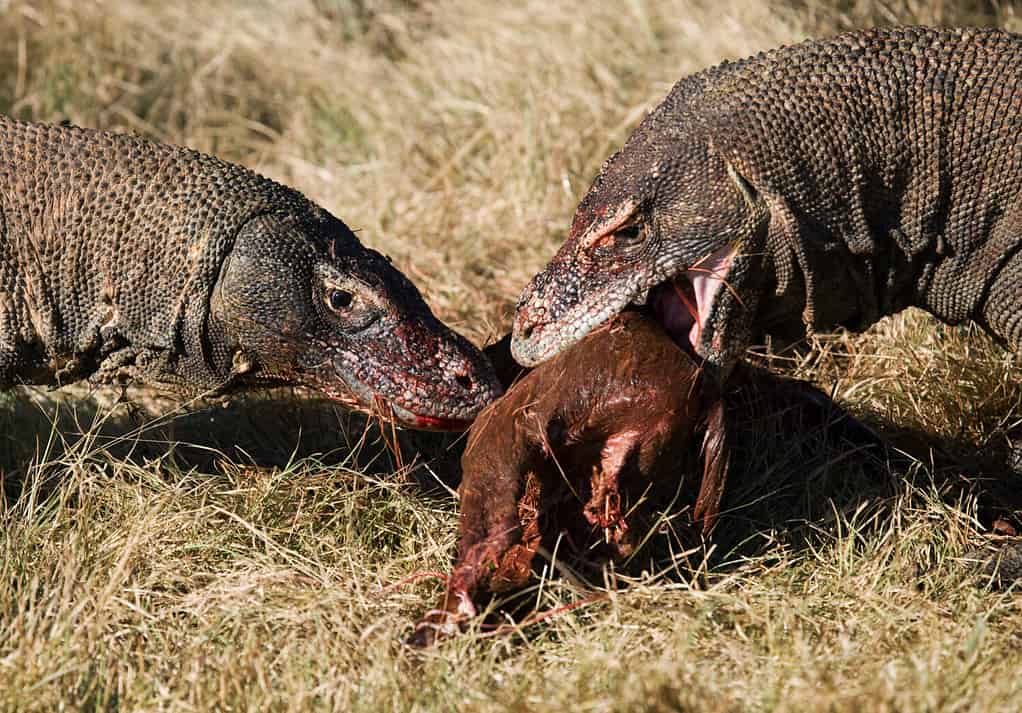Continue reading for our analysis...

Merciless Komodo Dragon Gulps Down a Live Baby Boar!
In the riveting and slightly chilling video below, a primal clash between a Komodo dragon and a wild baby boar unfolds in the mud beneath a building. The footage commences with the dragon clamping its powerful jaws around the young boar’s face. With unyielding determination, the outmatched boar puts up a fierce struggle.
It emits plaintive squeals as it battles against the dragon’s razor-sharp teeth.
As the confrontation ensues, the boar’s resistance gradually ebbs. Its movements become sluggish. Evidently, the Komodo dragon’s venom has infiltrated its system, inducing partial paralysis. Despite its weakening state, the boar’s distress calls persist. They are a poignant yet futile cry for assistance.

Komodo Dragon grabs a
goat
by the head, gripping its neck with its serrated teeth and letting its venom seep into the goat’s bloodstream.
©Sergey Uryadnikov/Shutterstock.com
With calculated precision, the colossal reptile widens its maw, embarking on a macabre banquet. Methodically, it consumes the baby boar. Each deliberate gulp propels the prey deeper into its cavernous throat. The boar’s anguished cries persist as its form vanishes incrementally down the dragon’s gullet. In a final, chilling sequence, the dragon secures the boar’s hind legs within its implacable jaws.
This action affects a grim finale as the unfortunate creature is swallowed alive. This gripping footage offers an unfiltered glimpse into nature’s unrelenting cycle of survival and predation.
Why Do Komodo Dragons Eat Their Prey Live?
Komodo dragons, in a distinct dining strategy, opt to engulf their prey whole. Unlike predators such as wolves and lions, which tear apart their meals during consumption to evade injury, Komodo dragons have evolved an alternative approach.
Their rationale lies in their paralytic venom – a potent defense mechanism. By delivering this venom when attacking, the dragons ensure that even live prey poses minimal risk during the feeding process. Because Komodos have flexible skulls, loosely articulated jaws, and expandable stomachs and throats they are able to swallow their prey whole, which is normal for this species.
This strategy obviates the need to immobilize prey prior to consumption. In contrast, wolves or lions aim to minimize potential harm. Thus, the Komodo dragon’s venom not only aids in hunting but also provides a safe, efficient way to consume their meals whole.
This unique feeding behavior showcases the dragon’s adaptation to its environment and the nuanced interplay between predation and survival strategies.

Another reason Komodo Dragons swallow their prey whole is to avoid having their meal stolen by rival dragons!
©GUDKOV ANDREY/Shutterstock.com
The History of Komodo Dragons!
The history of Komodo dragons is as intriguing as the creatures themselves. These remarkable reptiles were first brought to the world’s attention in 1910. Lieutenant Van Steyn van Hensbroek, a Dutch official, encountered them on Komodo Island. Subsequently, a Dutch scientific expedition in 1926 shed light on their existence, leading to their formal scientific description.
Komodo dragons are relics of an ancient era. They have existed for millions of years in isolation on their native islands in Indonesia. Evolving alongside their unique environments, they’ve grown into the world’s largest lizards. With a reputation as apex predators, they use stealth and power to hunt a range of prey. Their targets include small mammals and larger animals.
Their distinctive features, including serrated teeth and rugged scales, have evolved over time for survival. Today, Komodo dragons remain a living testament to the planet’s rich evolutionary history. They continue to captivate researchers and nature enthusiasts alike.
Thank you for reading! Have some feedback for us? Contact the AZ Animals editorial team.






